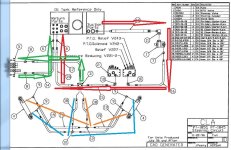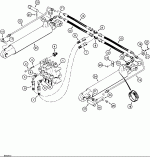A few minor thoughts, for what they are worth.
1) the volumes on either side of the cylinder are not equal. One side has the piston it, the other doesn't. Nor are the cylinder face areas the same.
2) That also means that the effective force differs on the two sides, because the area of each cylinder face is different. (Pressure x area= force, i.e. the pressure difference on the two sides is the force that moves the cylinder). You see cylinders rated for extension/retraction force- this is why. That is also why the extension/retraction speeds are different.
3) At rest, the pressures on both sides are equal. The valve body allows high pressure into one side, and connects the other side to the tank, creating the pressure difference that generates the force that causes the cylinder movement. Basically, opening the valve causes a pressure difference, the cylinder moves to restore the equilibrium, causing the motion that we all benefit from. From a design perspective, you want to add pressure and bleed pressure gradually.
4) Ken's description is true for a compressible fluid, like a gas. For an incompressible fluid, such as hydraulic fluid, to get significant movement, you have to allow fluid in/out of the cylinder sides. In the ideal case, imagine plugging one side of the cylinder. The cylinder won't move no matter how much the pressure changes on the other side. (For real materials- the oil is slightly compressible, and the steel will flex, but only trivially.)
5) If you have a look at hydraulic valve designs, you will see that some cylinders have both sides locked at rest, some have one side connected to the tank, and some connect both sides of the cylinder to each other. (i.e. the "Float" position.) I think of "Float" as a short circuit. (Draft control works by keeping a fixed pressure in the lift side of the cylinder, which is why you don't want to have draft and float engaged at the same time- nothing works, and you are dumping oil from the pressure side to the tank constantly.)
6) If the volume of the hoses is smaller than the volume changes in the cylinders, the oil will exchange. If it isn't, it won't. (Neglecting diffusion.) It is my
belief that for the PTs that is true. I have not run the math exactly, but here is a guesstimate;
Assume a 2" cylinder ID, with 10" of movement. That is about 31Cu.in. of oil volume change.
Steering hoses have about a 1/4" hose ID. Dividing that area into 31 cu in, that says that about 640" of hose contains 31 cu. in. of oil.
640" is 53' of hose. So, I would suggest that the oil is probably turning over. From a manufacturing point of view, you would want this to get rid of residual air in a cylinder.
As to why Carl's cylinders were filled with crud... I'll let Carl offer up his thoughts, but it is my impression that his PT is now in a good home, but that prior to arriving in Carl's hands it may have had a hard life, and that may have had something to do with it.
Sorry for the long post. I hope that it helps.




